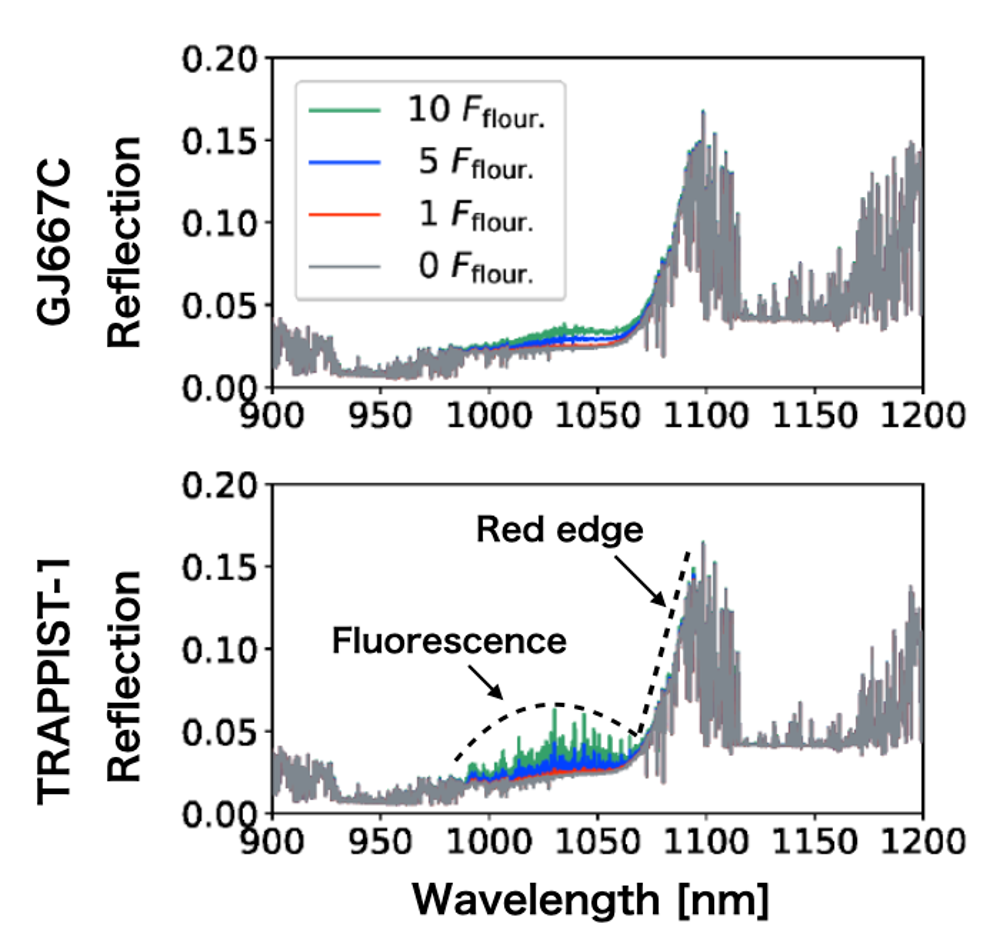Yu Komatsu, a researcher at the Astrobiology Center (ABC), and his collaborators estimated for the first time by numerical simulation how photosynthesis-derived fluorescence could be detected as a biosignature of life in future observations of extrasolar planets and discussed in detail based on our knowledge of photosynthesis. The results suggest that although fluorescence detection will be difficult with a future planned 6-meter aperture space telescope, some conditions and features will facilitate the identification of planets around ultra-cool dwarfs such as TRAPPIST-1. The results, which were obtained through discussions across multiple disciplines from biology to astronomy, were published in the online edition of the American scientific journal “The Astrophysical Journal” on 11th January, 2023 (Komatsu et al., 2023).

The search for life on exoplanets is one of the most important themes in the field of astrobiology. As evidence for the existence of such life, it is expected to detect biosignatures (Note 1) that show characteristic patterns of photosynthesis-derived light. One of these is the red edge (Note 2), a spectroscopic feature of the light spectrum reflected by vegetation. For example, the light environment of planets around stars lighter than the Sun (M dwarfs), which are currently the target of observation, is very different from that of the Earth in our solar system, and it is under discussion how the red edge appears.

In photosynthesis, light energy absorbed from sunlight is either used for photochemical reactions or released as fluorescence (Note 3) or heat (Figure 2). Remote sensing of the Earth has recently observed the fluorescence as well as the red edge. The red edge allows us to measure the amount of vegetation covering the planetary surface, whereas the fluorescence is used to estimate more detailed photosynthetic activity, such as stress conditions. We, therefore, tested the promise of photosynthetically derived fluorescence as an advanced biosignature in addition to the red edge.

In this study, we simulated how fluorescence appears in planetary spectra for a Sun-like star and an Earth-like planet orbiting two M-type dwarfs (GJ667C and TRAPPIST-1), respectively, assuming different planetary atmospheres and surface conditions. We used two light absorption and fluorescence spectra of photosynthetic organisms: typical vegetation with chlorophyll a and b (Chl) and purple bacteria with bacteriochlorophyll b (BChl). We determined the fluorescence intensity by appropriately scaling it according to the number of photons acquired under radiation fields in the habitat. Using these light absorption spectra, we also calculated the leaf reflection spectra by means of radiation transfer calculations (Note 4). In this way, we developed a model that consistently handles light absorption, fluorescence, and reflection, and investigated how they appear in planetary spectra.
Numerical simulations showed that, in the case of BChl, in the absence of clouds or strong absorbers around 1,000 nm, the fluorescence, together with the detection of red edges, can be a good biosignature to identify traces of photosynthesis (Figure 3). However, a noise model assuming NASA’s planned future 6 m aperture space telescope (previously considered as LUVOIR, now called the Habitable Worlds Observatory) around solar-type stars, we also found that it takes a very long observation time to identify the fluorescence. Even so, ultra-cool stars such as TRAPPIST-1 have strong absorption of vanadium oxide (VO), iron hydride (FeH), and potassium in the stellar atmosphere, and interestingly these lead to significantly larger apparent reflectance at wavelengths where the flux from the star is small due to this stellar absorption, and fluorescence emission from the planet. This may be a good feature for observing fluorescence at high dispersion by future large ground-based telescopes such as TMT and needs to be verified in the future. Furthermore, it is important to consider the conditions for large fluorescence emission from the physiological perspective of photosynthesis and to capture the nonlinear response of biological fluorescence relative to the incident light since fluorescence is also generated nonbiologically.
At ABC, young researchers actively collaborate across the boundaries of research fields between astronomy and biology, and observation, experiment, and theory. This study results from such activities and has been compiled as an academic paper. This is truly an achievement that links biology and astronomy, and theory and observation.
Footnotes :
(Note 1) Spectral features of atmospheric molecules such as oxygen, ozone, and methane, and the surface feature, e. g., due to vegetation.
(Note 2) A feature in which the reflectance spectrum of leaves increases sharply around 700 nm.
(Note 3) The light emitted when electronically excited states by light quenched to a low-energy state.
(Note 4) A calculation method that deals with light propagation.
Publication Information :
Journal: The Astrophysical Journal
Title: Photosynthetic Fluorescence from Earth-like Planets around Sun-like and Cool Stars
Authors: Yu Komatsu 1,2, Yasunori Hori 1,2, Masayuki Kuzuhara 1,2, Makiko Kosugi 1,2,3, Kenji Takizawa 1,3, Norio Narita 4,1, Masashi Omiya 1,2, Eunchul Kim 3, Nobuhiko Kusakabe 1,2, Victoria Meadows 5, Motohide Tamura 1,2,4
1) Astrobiology Center, 2) National Astronomical Observatory of Japan, 3) National Institute for Basic Biology, 4) University of Tokyo, 5) University of Washington
DOI: 10.3847/1538-4357/aca3a5

